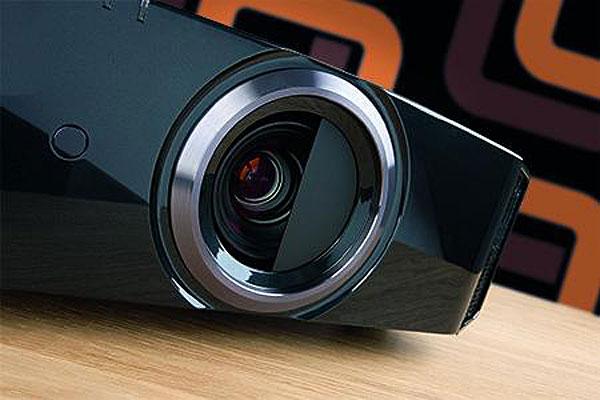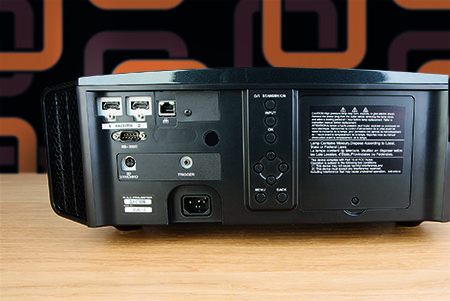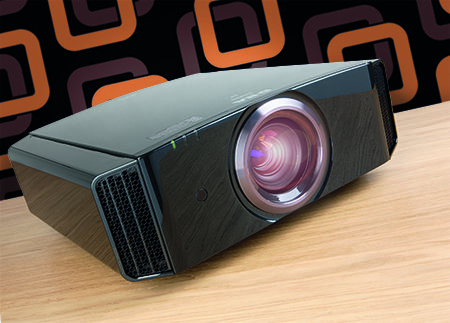JVC DLA-X7000 review


The question is: will HDR’s extreme image demands help the DLA-X7000 shine, or prove the undoing of a technology that tends to favour deep blacks over HDR-friendly brightness?
While significant changes might have gone on inside the X7000, it presents a familiar face to the world with its elliptical, stretched body, large centrally-mounted lens, glossy black finish and venting ‘wings’. It’s not glamorous, but it looks – and feels – like it means business.
The X7000 doesn’t carry much in the way of inputs, but it makes those it does have count. The twin HDMIs are 2.0a affairs with support for the 4K-era HDCP 2.2 anti-piracy protocol, 10-bit 4K/UHD HDR at frame rates of up to 60Hz, and 18Gbps data rates. It also has an Ethernet port for firmware updates, and a 3D emitter hookup (some dealers even appear to be providing free glasses).
The X7000’s 4K/UHD playback isn’t quite as you might expect, though, since the projector doesn’t actually sport a native 4K pixel count. Instead it uses JVC’s e-Shift technology to give HD images a 4K feel by pushing them through two Full HD imaging chips offset diagonally by half a pixel.
As ever, this sounds dubious. Especially as native 4K images have to be downscaled to 1080p before traversing the projector’s optics; hardly music to the ears of AV fans desperate for pixel-by-pixel 4K thrills. And while previous e-Shift 4K generations haven’t delivered the same clarity and crispness with 4K content as Sony’s native 4K PJs, the system has proved more effective than you might think. Especially when it comes to adding detail and texture to HD sources. Fingers crossed it delivers at least the same quality here.
The X7000 claims to produce 1,800 Lumens of brightness – a rise of nearly 40 per cent over 2014’s X700 model. It puts the X7000 on a brightness par with Sony’s £8,800 native 4K VW520ES, also an HDR challenger.
Remarkably, the X7000 claims a native – as in, with no dynamic light controls – contrast ratio of 120,000:1. Other projectors may claim similar numbers by reducing image stability with dynamic iris systems, but JVC’s D-ILA technology is the only home projector system that can get close to such huge numbers natively. If you opt to use the X7000’s optional dynamic iris system, its claimed contrast ratio balloons to – drum roll please – 1,200,000:1. Yikes.
As well as utilising excellent motorised image shifting, zooming (2.0x) and focusing, the X7000 is stuffed to bursting point with calibration tools. Gamma, colour and white balance management are all present, with exceptional flexibility in every department. Not surprisingly, the projector is endorsed by the Imaging Science Foundation (ISF) as a model its engineers can professionally fettle. There’s also a wide-ranging and generally well-developed set of themed picture presets, including a THX mode because the projector is THX-certified for both 2D and 3D.

In action the X7000’s picture quality is… confusing. In a mostly great way. For while it doesn’t totally convince with the HDR 4K content I’d expected to be the star of its show, it does a groundbreakingly magnificent job with standard dynamic range (SDR) sources.
Let’s deal with the bad news first. Which is that the X7000 doesn’t seem to have quite enough brightness to do full and consistent justice to HDR content.
Right away, for instance, I noticed that HDR pictures on the X7000 look markedly less bright overall than SDR ones – a decision JVC seems to have taken so that HDR’s luminance highlights have more room to shine (literally). This lack of overall HDR brightness – even though HDR requires you to run the lamp on its High mode, causing increased cooling fan noise – can look uncomfortable during dark scenes, such as Moses’ night-time meeting with Nun in a torch-lit hut in Ridley Scott's Exodus: Gods and Kings. The darkest areas look hollow – like black holes – and some of the shadows on faces and walls appear slightly forced.
Difficulties with mapping the HDR gamma of the Exodus... Ultra HD Blu-ray to the X7000’s relatively limited brightness causes issues, too, with scenes that feature dark objects against a bright backdrop. When two assassins attack Moses while he’s sleeping in the desert, for instance, the actors and Moses’ dead horse all seem slightly silhouetted against the brightness behind them, losing shadow detail and colour information compared with the same scene on the standard dynamic range Blu-ray.
It’s important to say at this point that there are moments – plenty of them – when HDR looks pretty amazing on the X7000. During the coronation of Ramses sequence, his ceremonial robes glinting in the Egyptian
sun stand out against the darker background areas with an intensity and radiance that far exceeds the dynamics you get with the SDR platter. There’s a slight (though not jaw-dropping) boost to colour saturations with HDR content too, and while the core brightness of HDR images isn’t the best, some shots still contain enough extra dynamic range to look exquisite.
Yet overall the tough demands HDR material (UHD Blu-ray flavoured at least) places on the X7000 cause pictures to look less consistently brilliant than they do with regular fare. And this is because its standard dynamic range pictures really are incredible.
SDR superstarThe most immediate star of the show is the JVC's contrast. Pure whites and bold colours share the frame effortlessly with the inkiest, deepest, most convincing black levels you're likely to find on any video-chucker at the £5,700 price point. What’s more, even the darkest areas contain exceptional amounts of shadow detail and colour subtlety.
This means that the extremely high-contrast Exodus... Blu-ray scene where Moses and Ramses have a tense conflab in a torch-lit room, while Ramses symbolically milks snake venom, comes across as more full of depth and detail than I’ve ever seen it look before on a projector. By miles.
It’s also appealing to witness the X7000 delivering such a class-leading contrast performance without suffering any of the light instability associated with those projectors (as in, most of them) that resort to using dynamic irises to hit convincing black level depths.
And, as I'd hoped, it’s not just dark scenes that benefit from the X7000’s top-notch contrast performance. The gorgeous blacks provide the perfect foundation for brighter scenes, contributing to a healthy sense of dynamism without the need for any HDR help from the source. It's an appealing trait.
The X7000 also excels with its SDR colour handling. Even if you stick with the most movie-centric of its picture presets the combination of range, finesse and naturalism in its colour reproduction is always a joy to behold. With my Exodus... disc, the full extent of its colour qualities is particularly evident during the scene on the terrace of the Pharaoh's palace. Here the bright skies unite with the sandstone subtleties of the architecture, the actors’ varied skin tones and the luxuriantly vibrant hues of the royal family’s clothing to leave my jaw almost on the floor. And the scene where the High Priestess studies the river of blood also looks so good on the X7000 it makes every other projected image I’ve seen at the same sort of price look dull and coarse.
I haven’t mentioned the potentially controversial area of sharpness and resolution yet. But be in no doubt that however, erm, shifty e-Shift 4K might sound, the latest version of it works well. Full HD Blu-rays are thrown onscreen with attractive sharpness. And, yes, they appear more detailed than on a ‘straight’ Full HD projector.
What’s more, aside from very grainy content looking just a touch noisier than I’d like, the e-Shift system now delivers its apparent HD resolution boost with few unwanted side effects.

The situation is less clear cut with native 4K content; the JVC will accept a UHD source, it just can't display it faithfully. Sony’s SXRD-based 4K projectors enjoy more detail with 4K sources. There’s a marginally more processed feel to the JVC’s down-converted/up-rezzed native 4K playback. And while I would love to be able to afford JVC's incoming native 4K home cinema projector, the £30,000 DLA-Z1, the difference between native and e-Shift 4K seems less obvious with the X7000 than it has been with previous models.
Plus, I’d say HD sources actually fare better via e-Shift than they do once they’ve been through a native 4K projector’s upscaling engine.
With active 3D images the X7000 is pretty good. Its contrast heroics help it deliver a great sense of scale and detail both to Exodus’s many epic vistas and its often very dark interiors. The only issue is the appearance of some low-level crosstalk ghosting over objects in the mid-to-far distance, and the fact that e-Shift isn't an option when the JVC is fed a 3D source. Add in the fact that Ultra HD Blu-ray doesn't support 3D either, and stereoscopic fans will find themselves pegged at 1080p.
One other problem with the X7000 is a measured input lag of 130ms that seriously compromises its potential as a video gaming display.
The X7000’s issues with HDR make it actually a more satisfying watch with SDR content. If you want a more convincing HDR performance you’ll have to sacrifice dozens of inches of picture size and get a high-end 2016 TV instead.
Frankly, though, the X7000 is so absurdly brilliant for its money (Sony’s native 4K and HDR VW520ES costs more than £3,000 more) with ordinary Blu-rays that you may well decide that buying into Ultra HD Blu-ray and HDR isn’t as important as you previously thought...
Specification
3D: Yes, Active 4K: No. Full HD 1,920 x 1,080 (with e-Shift 4K pixel-shifting) Connections: 2 x HDMI inputs; 1 x Ethernet service port; 1 x 12V trigger output; 1 x RS-232; 1 x 3D emitter port Brightness (claimed): 1,800 Lumens Contrast (claimed): 120,000:1 native, 1,200,000:1 dynamic Zoom: 2.0x motorised Dimensions: 455(w) x 472(d) x 179(h)mm Weight: 15.6kg
Features: HDR playback; HDMI 2.0a inputs support HDCP 2.2 and 4K/60p 4:4:4 input; ISF support; THX certification (2D and 3D); Clear Motion Drive processing; noise reduction processing; full colour and gamma management; high/low lamp modes; motorised lens setup; built-in test signal; horizontal and vertical image shifting; claimed 21dB running noise (low lamp mode); Real Colour Imaging Technology; 10 x Lens Memory slots; wireless transmission
 |
Home Cinema Choice #351 is on sale now, featuring: Samsung S95D flagship OLED TV; Ascendo loudspeakers; Pioneer VSA-LX805 AV receiver; UST projector roundup; 2024’s summer movies; Conan 4K; and more
|























































